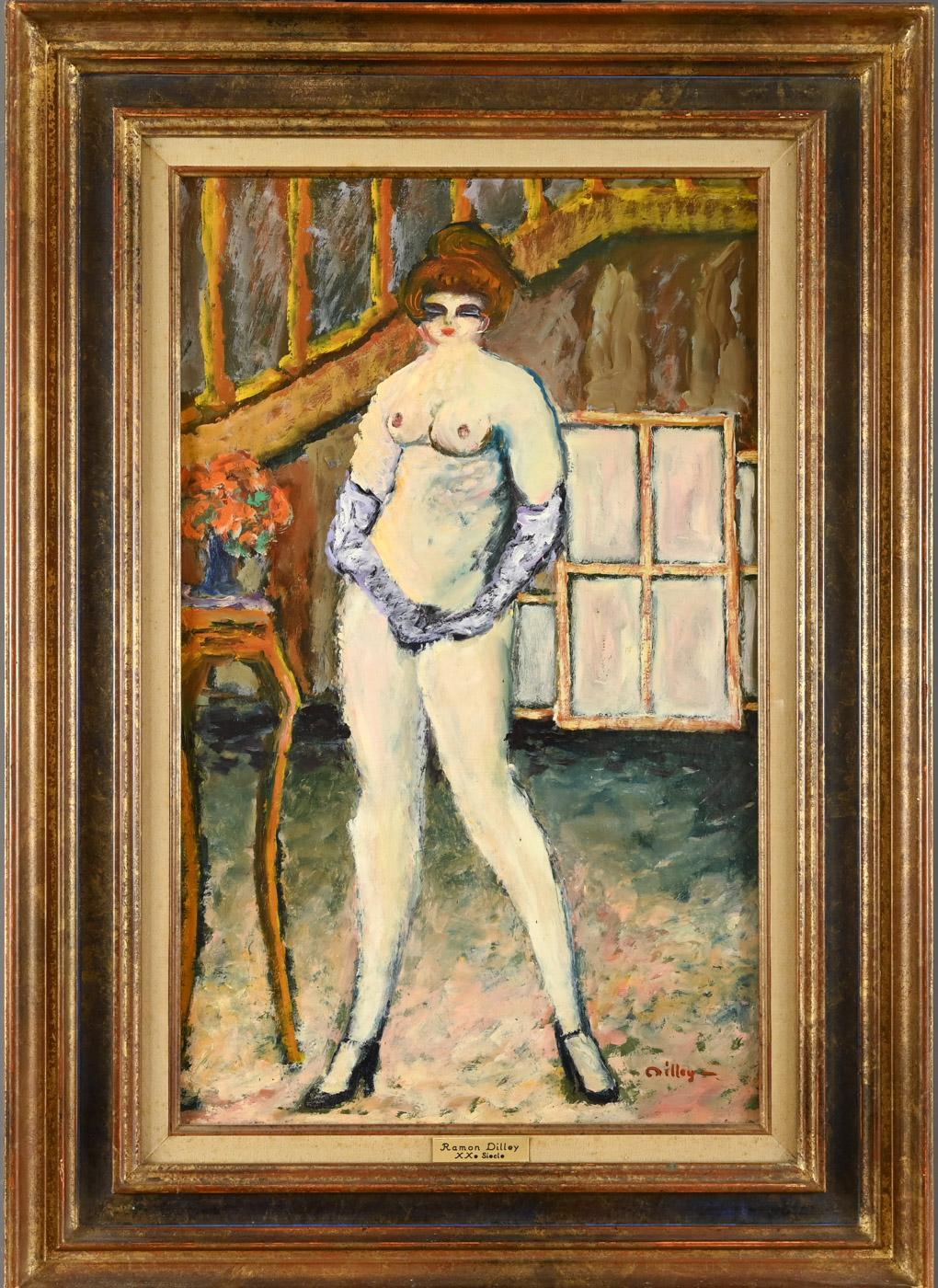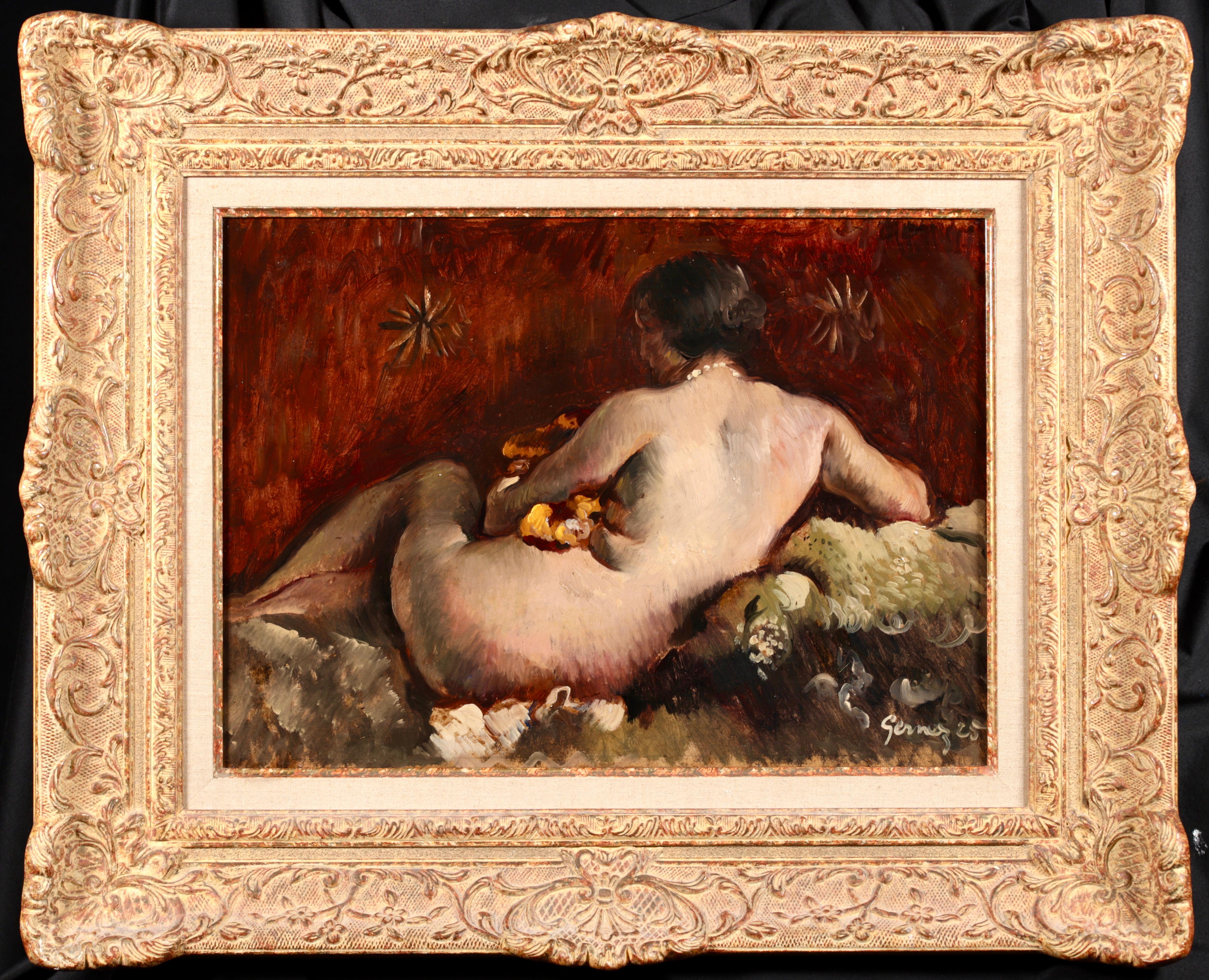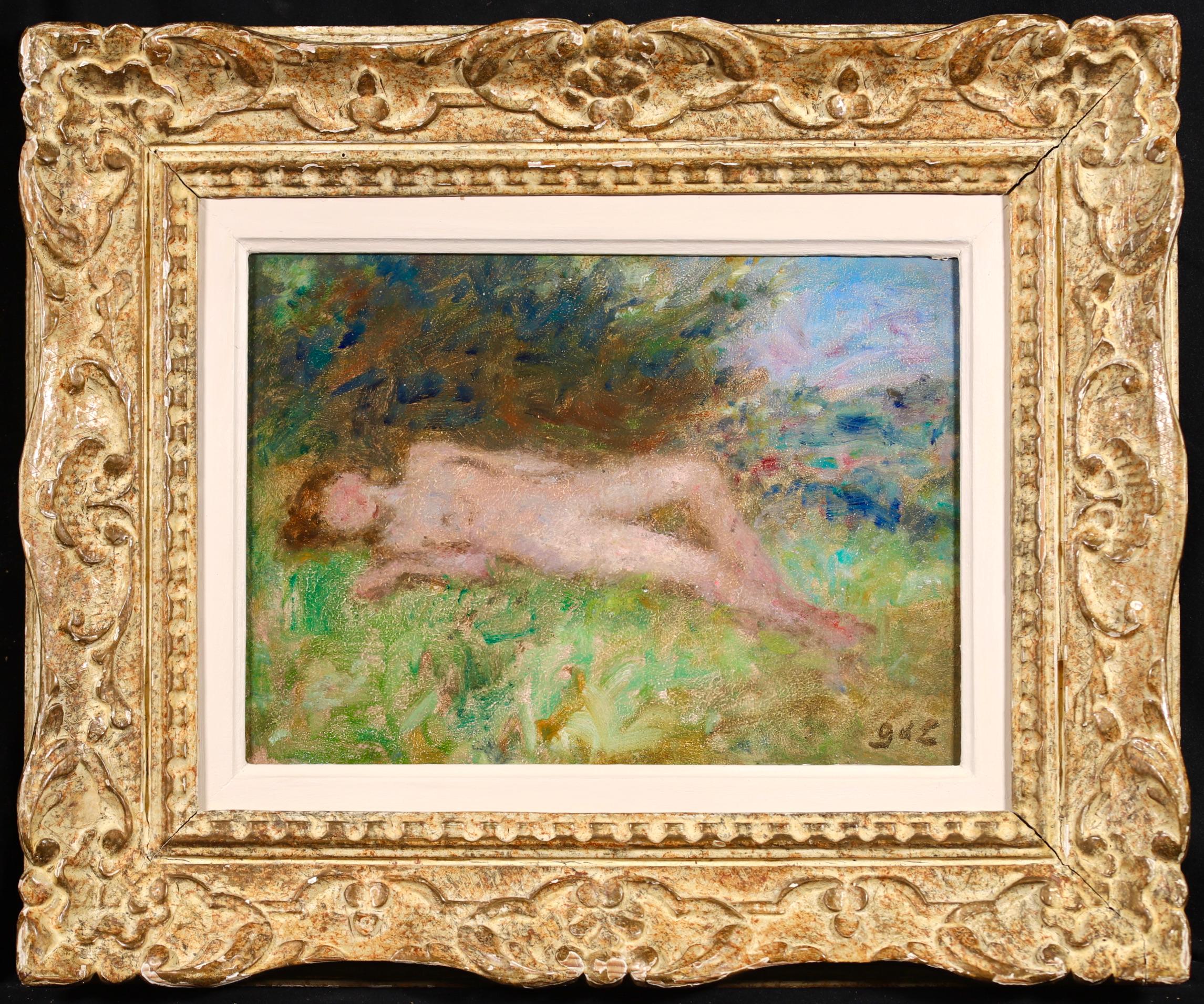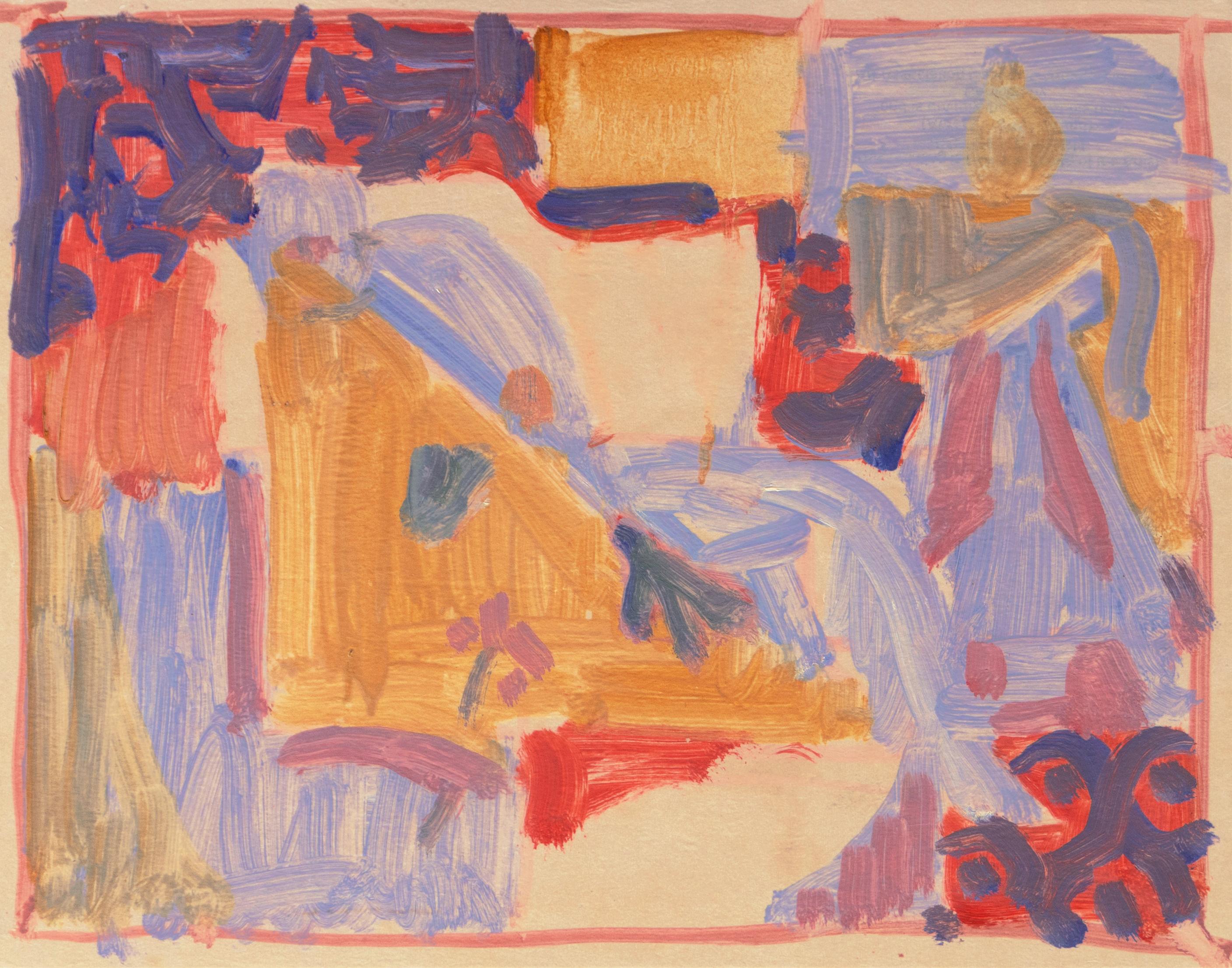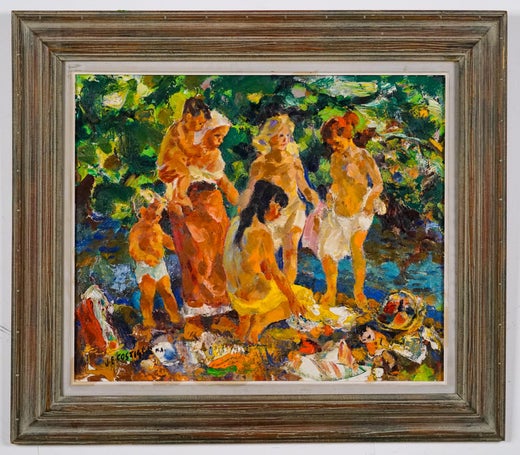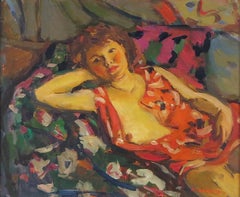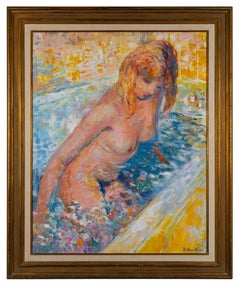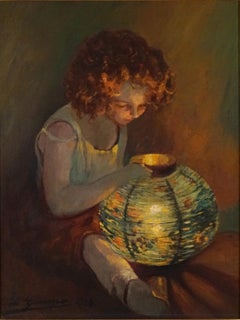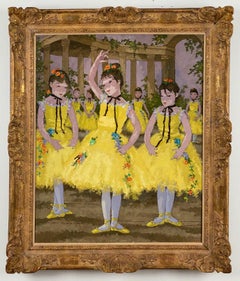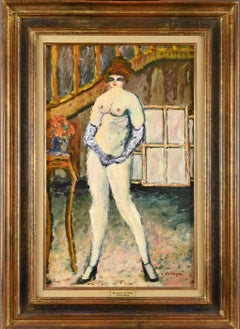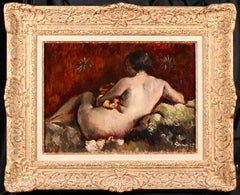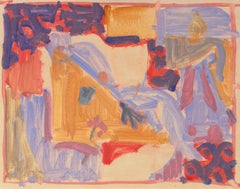Items Similar to Bathing Group
Want more images or videos?
Request additional images or videos from the seller
1 of 8
John Edward CostiganBathing Group1950's
1950's
About the Item
John Edward Costigan, N.A.
American, 1888-1972
Bathing Group
Oil on canvas board
Signed ‘J.E. Costigan N.A.’ lower left
12 by 16 in. W/frame 20 by 24 in.
John Costigan was born of Irish-American parents in Providence, Rhode Island, February 29, 1888. He was a cousin of the noted American showman, George M. Cohan, whose parents brought the young Costigan to New York City and was instrumental in starting him on a career in the visual arts. They were less successful in encouraging him to pursue formal studies at the Art Students League (where, however, he later taught) than in exposing him to the commercial art world through the job they had gotten him with the New York lithographing firm that made their theatrical posters.
At the H. C. Miner Lithographing Company, Costigan worked his way up from his entry job as a pressroom helper, through various apprenticeships, to the position of sketch artist. In the latter capacity he was an uncredited designer of posters for the Ziegfeld Follies and for numerous silent films. Meanwhile, he had supplemented his very meager formal studies in the fine arts with a self-teaching discipline that led to his first professional recognition in 1920 with the receipt of prizes for an oil painting and watercolor in separate New York exhibitions.
A year earlier, Costigan had wed professional model Ida Blessin, with whom he established residence and began raising a family in the sleepy little rural New York hamlet of Orangeburg, the setting for the many idyllic farm landscapes and wood interiors with which he was to become identified in a career that would span half a century.
John Costigan’s first national recognition came in 1922 with his winning of the coveted Peterson Purchase prize of the Art Institute of Chicago for an oil on canvas, “Sheep at the Brook.” It marked the start of an unbroken winning streak that would gain him at least one important prize per year for the remainder of the decade. The nation’s art journalists and critics began to take notice, making him the recurring subject of newspaper features and magazine articles. The eminent author and critic Edgar Holger Cahill was just a fledgling reporter when he wrote his first feature, “John Costigan Carries the Flame,” for Shadowland Magazine in 1922. Costigan had his first one-man show of paintings at the Rehn Gallery on New York’s 5th Avenue in November, 1924, to be followed less than three years later by another at the Art Institute of Chicago. In addition, Costigan’s work has been—and continues to be included, side-by-side with that of some of America’s most high-profile artists, in museum and gallery exhibitions throughout the country. His renown had peaked in the early 1930s, by which time his work had been honored with nearly every major award then being bestowed in the fine arts and had been acquired for the permanent collections of several prestigious American museums, including New York’s Metropolitan (which only recently, in 1997, deaccessioned his “Wood Interior,” acquired in 1934).
Although Costigan’s celebrity had ebbed by the late 1930s, the Smithsonian Institution saw fit in 1937 to host an exhibition exclusively of his etchings. And, in 1941, the Corcoran Gallery (also Washington, D.C.) similarly honored him for his watercolors. (Another Washington institution, the Library of Congress, today includes 22 Costigan etchings and lithographs in its permanent print collection.)
During World War II, Costigan returned briefly to illustrating, mainly for Bluebook, a men’s pulp adventure magazine. A gradual revival of interest in his more serious work began at the end of the war, culminating in 1968 with the mounting of a 50-year Costigan retrospective at the Paine Art Center and Arboretum in Oshkosh, Wisconsin. Oils, watercolors and prints were borrowed from museums and private collections throughout the country, and the exhibition was subsequently toured nationally by the Smithsonian Institution.
John Costigan died of pneumonia in Nyack, NY, August 5, 1972, just months after receiving his final prestigious award —the Benjamin West Clinedinst Medal of the Artist’s Fellowship, Inc., presented in general recognition of his “...achievement of exceptional artistic merit...” in the various media he had mastered in the course of his career.
This painting depicts one of the artist's favorite themes --the farm family bathing in the wooded creek that bordered his property in Orangeburg NY. Most of these were titled simply "Bathers" or "Bathing Group." This painting is truly representative of the artist's work in oils, particularly his later work.
Provenance:
Private Collection, New York
Alexander Avenard Collection
Le Trianon Fine Art & Antiques, Sheffield, MA.
Art C264
- Creator:John Edward Costigan (1888 - 1972, American)
- Creation Year:1950's
- Dimensions:Height: 20 in (50.8 cm)Width: 24 in (60.96 cm)Depth: 2 in (5.08 cm)
- Medium:
- Movement & Style:
- Period:
- Condition:
- Gallery Location:Sheffield, MA
- Reference Number:Seller: Art C2641stDibs: LU70037857872
John Edward Costigan
An American Painter Compositional painter of figures and country animals; watercolor painter Costigan was a largely self-taught artist. He moved from Providence, Rhode Island to New York City as an orphaned teenager in 1904 to work for a commercial poster company. It was here that he learned the rudiments of drawing and painting, skills he furthered with informal study at New York's Kit Kat Club, a popular artists' hangout. Costigan achieved national fame as a painter and printmaker in the1920s and 30s. He won numerous prestigious awards and, despite his lack of formal artistic training, was elected a full member of the National Academy of Design. In 1937 the Smithsonian Institution held a one-person exhibition of his graphic works. Famed American printmaker John Taylor Arms praised Costigan as "a brilliant etcher, particularly noted for his interpretation of life on the American farmstead." Today prints by Costigan can be found in private and public collections around the nation, including the Prints and Photographs Division of the Library of Congress in Washington, which owns twenty-two. The Swope exhibition is the largest devoted to Costigan's work since the late 1960s. Many of the forty-five prints in the exhibition are from the Swope's own extensive holdings of Costigan's works. Other are being lent by private collectors from around the country.
About the Seller
3.7
Vetted Professional Seller
Every seller passes strict standards for authenticity and reliability
1stDibs seller since 2017
51 sales on 1stDibs
Typical response time: 18 hours
- ShippingRetrieving quote...Shipping from: Sheffield, MA
- Return Policy
Authenticity Guarantee
In the unlikely event there’s an issue with an item’s authenticity, contact us within 1 year for a full refund. DetailsMoney-Back Guarantee
If your item is not as described, is damaged in transit, or does not arrive, contact us within 7 days for a full refund. Details24-Hour Cancellation
You have a 24-hour grace period in which to reconsider your purchase, with no questions asked.Vetted Professional Sellers
Our world-class sellers must adhere to strict standards for service and quality, maintaining the integrity of our listings.Price-Match Guarantee
If you find that a seller listed the same item for a lower price elsewhere, we’ll match it.Trusted Global Delivery
Our best-in-class carrier network provides specialized shipping options worldwide, including custom delivery.More From This Seller
View AllJeune Femme Alonge
By Pierre Cornu
Located in Sheffield, MA
Pierre Cornu
French, 1895-1996
Jeune Femme Alonge
Oil / Canvas
14 by 18 in. W/frame 20 by 24 in.
Signed lower right
Pierre Cornu was born November 16, 1895 in Salon de Provence.
Born into a prosperous family of merchants oils and soaps, Cornu knows a pampered childhood and happy during which his attraction to drawing and color manifests itself fairly quickly. He will have the opportunity, throughout his life to be able to concentrate on his passion of painting.
His paintings are often honored in all the great Parisian salons. He exhibits regularly with René Auguste Chabaud and Seyssaud in Marseille.
Financial troubles forced him to emigrate several years in Morocco where he begins a new life, never abandoning painting, perfecting his art (abundance of beautiful colors, resembling oriental tapestries...
Category
1930s Post-Impressionist Figurative Paintings
Materials
Oil
L’eau Tiède
Located in Sheffield, MA
Bernard Taurelle
French, born 1931
L’eau Tiède
Oil on canvas
28 ¾ by 36 ¼ in, w/ frame 36 ¼ by 43 ¾ in
Signed lower right
Bernard Taurelle graduated college at 19 with a degree in ...
Category
1970s Modern Nude Paintings
Materials
Oil
The Glow
Located in Sheffield, MA
LOUIS GRANER Y ARRUFI
(Spanish, 1863-1929)
The Glow 1923
oil on canvas
Signed & dated 23 lower left
In a Fine Giltwood Carved Frame
33 by 25 ½ in. W/frame ...
Category
1920s Post-Impressionist Interior Paintings
Materials
Oil
Ballet D'enfants
By Suzanne Eisendieck
Located in Sheffield, MA
Suzanne Eisendieck
French, 1908-1998
Ballet D'enfants
Oil on canvas
36 by 29 ½ in. W/frame 44 by 37 ½ in.
Signed lower right
She was born in Danzig (now Gdansk, Poland) in 1908 ...
Category
1960s Post-Impressionist Figurative Paintings
Materials
Oil
Dancing Girls
Located in Sheffield, MA
Bencion (Benn) Rabinowitch
Poland 1905 - Paris 1989
Dancing Girls
Oil on Board
14 ½ in. by 21 in. W/frame 21 ½ in. by 28 in.
He came from a rabbinic family, his father was an ar...
Category
1930s Post-Impressionist Figurative Paintings
Materials
Oil
Au Circus
By Dietz Edzard
Located in Sheffield, MA
Dietz Edzard
German, 1893-1963
Au Circus
Oil on canvas
22 by 31 in. W/frame 32 by 41 in.
Signed lower right
Dietz Edzard was born in Bremen in 1893 Germany. He traveled extensive...
Category
1930s Post-Impressionist Figurative Paintings
Materials
Oil
You May Also Like
La Carine-Celle de Bois-Le-Vent
Located in LE HAVRE, FR
Ramon DILLEY (né en 1932)
La Carine-Celle de Bois-Le-Vent
Oil on cardboard mounted on canvas
Painting dimensions: 61 x 48 cm
Signed lower right
Titled on the back
Provenance: Privat...
Category
Late 20th Century Fauvist Nude Paintings
Materials
Canvas, Oil
Nu Allonge - Post Impressionist Nude Oil Painting by Paul Elie Gernez
Located in Marlow, Buckinghamshire
Signed and dated nude oil on panel by French post impressionist painter Paul Elie Gernez. The work depicts a brunette nude relaxing on a fur rug, her ...
Category
Early 20th Century Post-Impressionist Nude Paintings
Materials
Panel, Oil
Nu allonge - Post Impressionist Nude Figurative Oil - Georges D'Espagnat
By Georges d'Espagnat
Located in Marlow, Buckinghamshire
Signed oil on panel nude circa 1920 by French post impressionist painter Georges D'Espagnat. The work depicts a nude woman laying a patch of green grass on top of a hill with a view of the valley in the distance.
Signature:
Signed lower right
Dimensions:
Framed: 16"x20"
Unframed: 9"x13"
Provenance:
A certificate of authenticity for this work is available from Mr. Jean Dominique Jacquemond upon request
Private French collection
From the beginning of his career, it was a constant concern of Georges d'Espagnet to assert his originality. His studies at the École des Arts Décoratifs, Paris, did not last very long, for he wanted immediate independence and decided to follow courses in the private academies of Montparnasse. In about 1900, he became acquainted with Maurice Denis, Bonnard and Vuillard, and his collaboration with Denis led to a renewal of religious art in France.
In 1903, d'Espagnet was one of the founders of the Salon d'Automne, and was appointed professor in charge of studios at the École des Beaux-Arts, Paris, in 1934. He illustrated a number of books: Rémy de Gourmont's Evil Prayers ( Oraisons mauvaises) (1896), The Saints of Paradise ( Les Saintes du paradis) (1898), Simone (1907), Sistine ( Sixtine) (1922); Alphonse Daudet's The Immortal ( L'Immortel) (1930); André Gide's The Pastoral Symphony ( La Symphonie pastorale); Francis Jammes' Clearings in the Sky ( Chairières dans le ciel) (1948).
D'Espagnet belongs to the group of artists who made the Courrier Français so successful. The drawings of his which are published in it are strongly expressive and some bear comparison with the designs of the great Renaissance masters. He also contributed to L'Image. He often placed cheerful nudes in a landscape, reminding us that, though he moved away from the Fauves, he retained their freedom of colour and arabesque. He painted many portraits, including those of Albert André, André Barbier, Victor Boucher, Déodat de Séverac, Albert Marque, André Marty and Albert Roussel. He also painted mural decorations, including a wall for the Palais de la Découverte (1937), the ceiling of the Victor Hugo Room in the Palais du Luxembourg (1939), a decorative panel for the Palais de Justice, Toulouse (1941) and interior decorations for private houses. His landscapes are Impressionist in inspiration, and work for a certain sobriety, an intimacy, both in their composition - one, two or three sketched figures and large open spaces - and in the choice of colours and treatment with the special hazy brushstroke that marks his style.
D'Espagnet took part in a number of annual Parisian exhibitions, including the Salon des Indépendants, the Salon de la Société Nationale des Beaux-Arts, the Salon d'Automne (from 1903 to 1949, except in special circumstances), the Salon de la Libre Ésthétique, Brussels (1899, 1901), the Berlin Secessionists (1940). He also exhibited at the first Salon de la Société de la Gravure sur Bois. Among other exhibitions were 1912, A Century of French Art ( Centenaire de l'art français), St Petersburg; 1916, Kunstverein, Winterthur; 1918, 1926, Galerie M. Bertheim, Paris; 1930, Contemporary French Art...
Category
1920s Post-Impressionist Nude Paintings
Materials
Oil, Panel
'Reclining Nude', Paris, Louvre, Salon d'Automne, Ac. Chaumière, LACMA, SFAA
By Victor Di Gesu
Located in Santa Cruz, CA
Painted circa 1955 by Victor Di Gesu (American, 1914-1988) and stamped verso with Victor di Gesu estate stamp.
Winner of the Prix Othon Friesz, Victor di Gesu first attended the Los...
Category
1950s Post-Impressionist Figurative Paintings
Materials
Oil, Paper
Fragment 9 (dreamy woman back skin female figurative painting soft Earth tones)
By Rudolf Kosow
Located in Quebec, Quebec
"Fragment 9" by Rudolf Kosow is a striking miniature painting that employs a minimalist yet impactful use of color and form to convey deep emotional and psychological states. The art...
Category
2010s Post-Impressionist Figurative Paintings
Materials
Canvas, Oil, Acrylic, Wood Panel
Fragment 7 (dreamy woman neck skin female figurative painting soft Earth tones)
By Rudolf Kosow
Located in Quebec, Quebec
"Fragment 7" by Rudolf Kosow is a deeply evocative miniature painting on wood that portrays the subtle details of a human profile with a focus on the neck and shoulder. The artwork's...
Category
2010s Post-Impressionist Figurative Paintings
Materials
Canvas, Oil, Acrylic, Wood Panel
